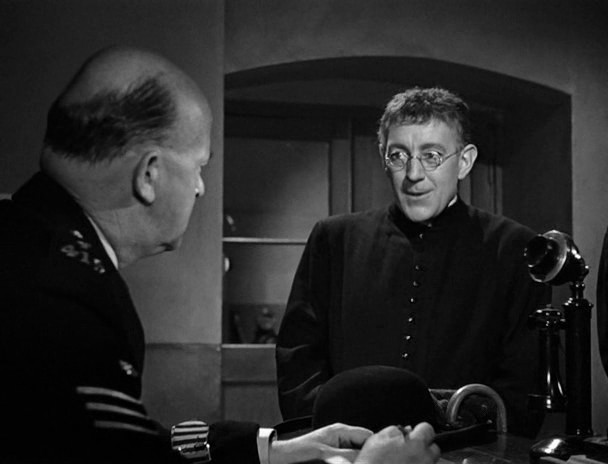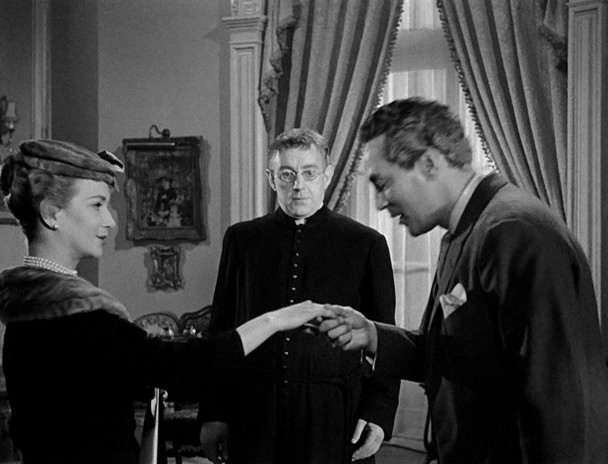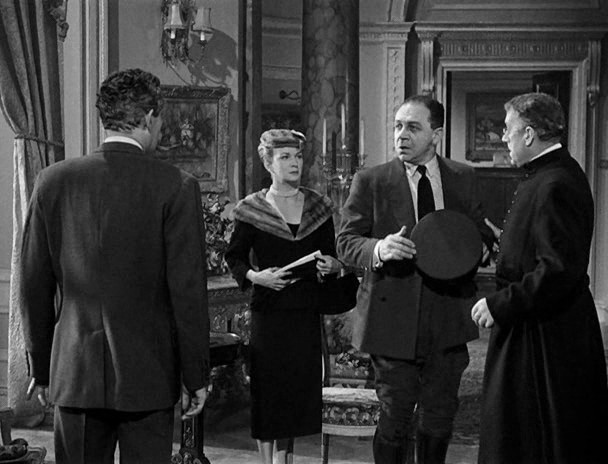Director: Robert Hamer
Writers: Thelma Schnee and Robert Hamer, from the Father Brown stories by G. K. Chesterton
Stars: Alec Guinness, Joan Greenwood, Peter Finch and Cecil Parker
 |
Index: 2021 Centennials.
It’s been Joan Greenwood week here at Apocalypse Later headquarters, because, hey, why not? Sure, I was trying to find an obscure but interesting picture from her career that I hadn’t seen but which would serve well as review material. I’d have watched the 1947 indie film called The White Unicorn, aka Bad Sister, given that it placed one of the most elegant British actresses ever to grace the screen in a home for delinquent girls, but I can’t find a copy anywhere. So I watched a bunch of others. After all, I’ve never heard a voice that does what her voice does to me. I could watch Joan Greenwood movies until the sun sets and until it rises again. Unfortunately, the excellent films I ran through didn’t feature her in a large enough role to warrant me covering them for her centennial. At least, I’m telling myself that and not that I merely don’t want to stop listening to that voice. It had a Scottish lilt in Whisky Galore! but was held back a little in The October Man. It’s just right, I feel, in Father Brown, a 1954 picture released in the U.S. as The Detective.
It reunited her with two major names: Robert Hamer, who had directed her in one of the blackest, sharpest features ever made, an Ealing comedy called Kind Hearts and Coronets; and its star, Alec Guinness, who played eight characters that time out but only one in this film, the titular priest, G. K. Chesterton’s timeless detective, Father Ignatius Brown. In between that picture in 1949 and this in 1954, she also played opposite Guinness in The Man in the White Suit, yet another classic Ealing comedy in a long line of them at that point, all of them absolute gems. She clearly got on well with Guinness and, while she’s not in Father Brown anywhere near as much as he is, their scenes together work very nicely indeed and her Lady Warren is the epitome of the elegant and unflappable but open and pixielike British lady that she played so often. It’s hardly surprising that she was able to hold her own in the 1952 adaptation of The Importance of Being Earnest, even with Edith Evans and Margaret Rutherford to contend with.
 |
Here, she’s merely one of Father Brown’s parishioners, one of a number of notable such, even if the others tend to be more notable for their criminal pasts. However, she has a collection of fine art, which gifts her with a number of worthy scenes midway through the film, as the eccentric priest and amateur detective sets a trap for a notorious art thief using her chess set as bait. Her first scene is to attend one of the father’s services and to chat with him afterwards, so he can gently suggest that she, a widow of two years, is mourning her late husband a little too long and also introduce her and us to the cross which hangs behind his pulpit and which will soon become the film’s MacGuffin. It belonged to St. Augustine, who died in 430 AD, meaning that it’s very old and very valuable, if a monetary amount can be placed on something like this. Without skipping ahead too far, I can safely mention that this script looks at the difference between price and value in human terms. The cross is “not valuable,” Father Brown tells her. It’s “priceless.”
We’ll spend much of this film catching up to what Father Brown catches very quickly, just as these early scenes with him and Lady Warren telegraph where we’re going to end up, even if it takes us almost the entire running time to realise it. Frankly, we ought to have grasped it from the lesson we’re given at the very beginning, that not everything is quite as it seems. The police speed up to a building at 3am and race inside, missing Sid James as he sneaks out, but nabbing Father Brown as he stocks the safe with money. At the station, he happily explains the situation: one of his parishioners committed the burglary, he says, and he “prevailed upon him to let me un-commit it.” As you might imagine, they don’t buy that and lock him up. Only as they’re looking into crooks known to masquerade as men of the cloth do they realise that he’s telling the truth and let him go. He thanks them for their hospitality, with all sincerity and, when he says, “It’s been most interesting,” we believe him. We should also learn to ask the right questions.
 |
The core of the story involves Brown’s bishop sending St. Augustine’s cross to Rome where the Eucharistic congress will soon meet, even though he knows that it’s going to be stolen, by a legendary art thief named Gustave Flambeau. Chesterton fans will raise their eyebrows at that, because, while this film is loosely based on the very first Father Brown story, The Blue Cross, published in 1910, the thief in that story was Hercule Flambeau, though, in both instances, Flambeau is a criminal pseudonym. Appropriately for religious mysteries, the spirit of the Father Brown stories is present here, even if the detail of them is not. The good father, having identified three different ways by which he could steal the cross on its journey to Rome, decides that the only thing for it is to take on the task of transporting it himself. Needless to say, he bumps into Flambeau and indulges in a battle of wits, which ends underground in the catacombs of Paris with Flambeau victorious. Now, Brown, who believes he will still win in the end, has to track the thief down.
And, to do that within the few days he has before he must answer to his archbishop for his loss of the cross, he has to set a cunning trap and that’s where his friend and parishioner, Lady Warren, comes in. I have to say that I was disappointed when the script took Brown over to the continent because clearly Lady Warren was always going to be staying in England, but Guinness won me over in the end. I was a little concerned about how he acted early on, as he appeared less like a criminal to me when explaining his actions to the police and more like an idiot. I think it was the combination of hairstyle and inane grin, accompanied by his stubborn refusal to take offence at anything. That could easily be read as a lack of understanding of what’s going on when it’s really understanding what’s going on much better than we could and rolling with it as needed. Brown is a deep soul, whose skill as an amateur detective is based not only in observation of details but in observation of people. He’s the spiritual equivalent to Sherlock Holmes’s scientist.
 |
By the time Brown visits Lady Warren at her sumptuous estate, he’s distracted by trying to get inside the mind of Flambeau, in the same way that William Peterson’s FBI profiler got inside the mind of the Tooth Fairy in Manhunter, just with the spiritual fortitude to do so without causing lasting trauma. It’s only when Lady Warren shows him some of her treasures that he figures out what he must do. They’re displayed with all the taste that we’d expect to see in the home of a Joan Greenwood character, including a small sculpture by Rodin, but it’s the chess set, the only one ever made by the 16th century Italian goldsmith Benvenuto Cellini, that has his attention and Lady Warren allows him to put it up for auction as the trap he so desperately needs. Thus far, the biggest joys of this film have come through the back and forth between Father Brown and Flambeau, once he’s rumbled. The dialogue is fantastic throughout, but that scene in the catacombs of Paris is magical stuff. It’s here, though, that Greenwood gets her teeth into things.
She comes truly alive at the auction. Lady Warren is no detective, but she knows they’re looking for a master of disguise and she’s able to identify candidates easily enough. Greenwood was short, only half an inch over five feet, and she looks short in long shots with her co-stars—Peter Finch, who plays Flambeau, had nine inches on her and Guinness ten—but she owns every scene she’s in through a sort of cultured acknowledgement of her role. She’s always dressed well, often in very high heels, but with magnificent posture and pristine composure. As she deflects candidates at the auction, she’s as utterly unflappable as the glorious auctioneer, all while her unique chess set is auctioned away, given back and then stolen from under their noses. It’s back home when they get there, along with its thief, who has returned it to make a point. Brown and Flambeau must make their escape in a purloined milk van, with the effortless Lady Warren left entertaining the police, in the form of Bernard Lee, Bond’s M, in memorable style.
 |
Joan Greenwood found herself often typecast as elegant ladies of this sort, enough so that it would be easy to suggest that she was born to play them, but she wasn’t. She was born in Chelsea to a portrait painter, Sydney Earnshaw Greenwood, and his wife Ida, a comfortable but hardly noble upbringing setting the arts in mind early on. She initially planned to be a ballet dancer but she chose instead to study at the Royal Academy of Dramatic Arts, debuting on stage in 1938 in Molière’s The Imaginary Invalid. She expanded her outreach quickly, appearing on television as early as 1939, only a dozen years after the birth of the BBC, and in feature films by 1941. Her American break didn’t come until she was well established in the UK, appearing on Broadway by 1954 and in Hollywood a year later, replacing Merle Oberon in the MGM production of Moonfleet, under the direction of Fritz Lang, once again playing a lady with a title, this time Lady Clarista Ashwood, the screen wife of George Sanders, who was almost as unflappable as Greenwood.
It’s interesting to watch her in early films, because her unforgettable voice took time to develop. I enjoyed The October Man, a story about a man unfairly pegged as a murderer, in part because he had spent some time recovering from a brain injury. Greenwood is both love interest and reason to live and fight and go on for John Mills and it’s not hard to see why he falls in love with her at first sight. I’d like to watch The White Unicorn one day and A Girl in a Million too, both films made while she was contracted with the Rank Organisation, but her stardom really began at Ealing, with Whisky Galore!, the timeless tale of a remote Scottish island that runs dry of whisky, only for a ship to run aground on it with fifty thousand cases of the stuff on board. She’s not in it much, but her scenes are magnetic and she proves to be a glorious tease to the sergeant who wants to marry her. Kind Hearts and Coronets, one of the very best comedies ever made, was another Ealing comedy made the same year, with The Man in the White Suit two years later.
 |
She made surprisingly few films over a career that lasted almost half a century, only thirty-one of them, twenty-two of which came out in the forties and fifties. While I’ve enjoyed her work in later pictures, like Mysterious Island, Tom Jones and The Uncanny, she was better known in later years on television, often in TV movies or stage adaptations. I find it interesting to note that she played Cicely in The Importance of Being Earnest on the BBC in 1949, before her more famous role of Gwendolen on the big screen in 1952, though it was Edith Evans stealing scenes as Lady Bracknell in both versions. Her first regular series role didn’t come until 1980, a BBC drama called Wainwright’s Law, which I don’t remember at all. However, I’m shocked to discover that she was a regular in Triangle, a show I remember despising. Now I should seek it out to find out why! Her final role was also on TV, in Melba, an Australian show about the soprano Nellie Melba, playing a German mezzo-soprano, Mathilde Marchesi. I can’t imagine Greenwood’s voice speaking German!
And, as impressive an actress as she was and as effortlessly elegant and unflappable, it was always that voice that identified her. It’s been ably described as a husky purr but my favourite description of her voice is that she sounded like “gargling with champagne”. I always felt that it was the essence of seduction transformed into sound. She could be reading the phone book and I would still melt listening to her. The icing on the cake is that, however many ladies and duchesses and countesses she played, she always gave off a feeling of approachability. We peasants might not be able to woo and win her characters, but they would happily talk to us. Father Brown tells Bert, the thief whose theft he un-committed early in this film, that he’s an incompetent thief. “You’re clearly incapable of earning a dishonest living. Why not experiment with an honest one?” He promptly lands him the job of being chauffeur to Lady Warren and, as common as muck as he is, I’m sure that he and her ladyship got on like a house on fire.
 |
I’m not sure which of the films I’ve watched this week I like the most. Whisky Galore! is timeless, even if it was the point at which the Ealing studio started to adapt to the comedies for which they’re still best known, 1949 being the year not only of Whisky Galore! but Passport to Pimlico and Kind Hearts and Coronets. The October Man was fascinating, but it was a worthy showcase for John Mills rather than Joan Greenwood. Similarly, Father Brown is a showcase for Alec Guinness, but where it fits on the scale doesn’t really matter in the end; it features a better role for Greenwood and it’s her and her career that I’m remembering today, on what would have been her one hundredth birthday. She died suddenly in 1987, four days before her 66th birthday, while still working and enjoying a life that had been good to her. She left a good legacy. Her husband, the actor André Morell, died nine years earlier, but Jason, their son, is still active today, as versatile as his parents as an actor and director on stage, television and film. He’s a fitting tribute.



No comments:
Post a Comment